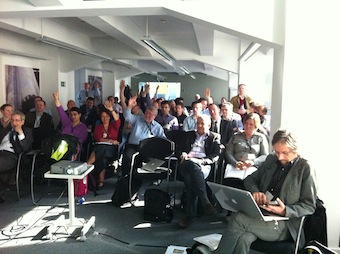Feedback on the 2012 airtightness workshop
 On behalf of AIVC and TightVent Europe, INIVE organized the workshop entitled “Achieving relevant and durable airtightness levels: status, options and progress needed” in Brussels, March 28-29 2012. 70 participants exchanged their views on the basis of presentations given by 20 experts representing 10 countries on requirements, quality and durability issues with regard to building airtightness.
On behalf of AIVC and TightVent Europe, INIVE organized the workshop entitled “Achieving relevant and durable airtightness levels: status, options and progress needed” in Brussels, March 28-29 2012. 70 participants exchanged their views on the basis of presentations given by 20 experts representing 10 countries on requirements, quality and durability issues with regard to building airtightness.
Concerning requirements, several speakers have underlined the opportunity with airtightness to move to the era of performance checks with measurements. Experience with mandatory testing schemes in regulations (e.g., in the UK) or low-energy programmes (e.g. Effinergie, Guaranteed Performance Homes) have shown the virtue of airtightness measurements to urge building professionals to revisit their methods and techniques.
However, especially if such measurement requirement is attached to a regulation, the tests have to be reliable and their results consistent with the inputs in the energy performance calculations. This is the reason why several bodies have engaged in qualification or certification schemes for air leakage testers. Examples from France, Germany, United Kingdom, Finland, Japan were discussed during the workshop, but initiatives have also been identified in Denmark or Norway for instance.
Speakers have also underlined the benefits of methods to secure desired airtightness levels, contain costs and avoid unpleasant surprises including building damage. The French and Japanese frameworks giving credit to builders who have implemented quality management approaches while requiring tests to be performed on a sample of the production only are worth considering because of cost and testers availability issues as well as their encouragement for builders to engage in quality schemes.
A method and device has been developed in Germany to test the fatigue of adhesives due to wind stress with artificially aged samples, which should be used as the basis for justifying the durability requirement in the German regulation. There is also work on-going in Belgium and Sweden to characterize airtightness durability. These initiatives could be important steps for securing airtightness levels over the buildings’ lifetime. However, the discussions also showed that airtightness durability characterization remains a topic where significant research is needed.
Nevertheless, from a practical point of view, experience shows that durability can be seriously affected by poor design and execution or inappropriate interventions of users and occupants. Although there is no scientific evidence of this, it seems reasonable to assume that quality approaches implying a well-designed and implemented airtightness strategy is more likely to remain effective in time than last-minute remedial actions. Therefore, fostering such approaches and informing occupants and users appear to be effective short-term actions to make significant progress in practice with regard to airtightness durability.
More information on the event.
